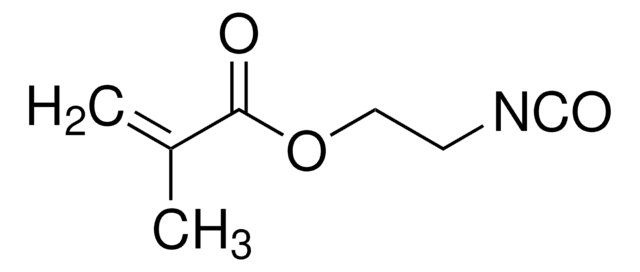305405
Octadecyl-Isocyanat
≥90%
Synonym(e):
1-Isocyanatooctadecane, 1-Octadecyl isocyanate, ODI, Stearyl isocyanate, n-Octadecyl isocyanate
About This Item
Empfohlene Produkte
Dampfdruck
1 mmHg ( 154 °C)
Assay
≥90%
Brechungsindex
n20/D 1.45 (lit.)
bp
172-173 °C/5 mmHg (lit.)
mp (Schmelzpunkt)
15-16 °C (lit.)
Dichte
0.847 g/mL at 25 °C (lit.)
Lagertemp.
2-8°C
SMILES String
CCCCCCCCCCCCCCCCCCN=C=O
InChI
1S/C19H37NO/c1-2-3-4-5-6-7-8-9-10-11-12-13-14-15-16-17-18-20-19-21/h2-18H2,1H3
InChIKey
QWDQYHPOSSHSAW-UHFFFAOYSA-N
Suchen Sie nach ähnlichen Produkten? Aufrufen Leitfaden zum Produktvergleich
Anwendung
- surface of cellulose nanocrystals to promote interfacial filler/matrix interactions
- poly (2-hydroxyethyl methacrylate) (pHEMA) films, to investigate in vitro hemocompatibility assay using freshly drawn human whole blood
- cellulose nanocrystals (or whiskers) and microfibrillated cellulose (MFC)
Signalwort
Danger
Gefahreneinstufungen
Acute Tox. 4 Dermal - Acute Tox. 4 Inhalation - Acute Tox. 4 Oral - Eye Irrit. 2 - Resp. Sens. 1 - Skin Irrit. 2 - Skin Sens. 1 - STOT SE 3
Zielorgane
Respiratory system
Lagerklassenschlüssel
6.1C - Combustible acute toxic Cat.3 / toxic compounds or compounds which causing chronic effects
WGK
WGK 1
Flammpunkt (°F)
300.2 °F - closed cup
Flammpunkt (°C)
149 °C - closed cup
Persönliche Schutzausrüstung
Eyeshields, Faceshields, Gloves, type ABEK (EN14387) respirator filter
Analysenzertifikate (COA)
Suchen Sie nach Analysenzertifikate (COA), indem Sie die Lot-/Chargennummer des Produkts eingeben. Lot- und Chargennummern sind auf dem Produktetikett hinter den Wörtern ‘Lot’ oder ‘Batch’ (Lot oder Charge) zu finden.
Besitzen Sie dieses Produkt bereits?
In der Dokumentenbibliothek finden Sie die Dokumentation zu den Produkten, die Sie kürzlich erworben haben.
Kunden haben sich ebenfalls angesehen
Unser Team von Wissenschaftlern verfügt über Erfahrung in allen Forschungsbereichen einschließlich Life Science, Materialwissenschaften, chemischer Synthese, Chromatographie, Analytik und vielen mehr..
Setzen Sie sich mit dem technischen Dienst in Verbindung.














